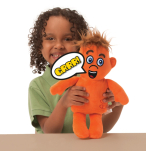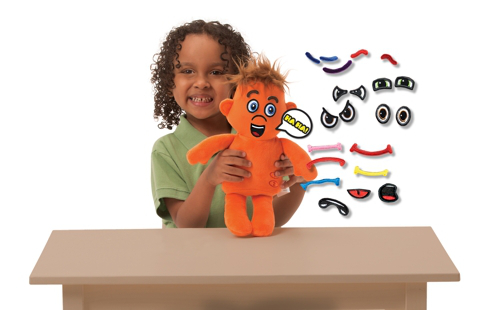
Be an emotions super hero with this snuggly doll!
This doll is an emotional super hero! Use it to encourage students to talk about their own moods and emotions. This cuddly doll comes with lots of different Velcro® facial features, allowing you to decide what the doll is feeling. Store other emotions on the doll’s cape. If you pull the cord on the doll’s back, you’ll hear 16 sounds (played randomly) that correspond with emotions. Ask students to match up the sounds with emotions!
Use the doll to encourage students to talk about their own moods and emotions. This cuddly doll comes with lots of different velcro facial features, allowing you to decide what the doll is feeling. Store other emotions on the doll’s cape. If you pull the cord on the doll’s back, you’ll hear 16 sounds (played randomly) that correspond with emotions. Ask students to match up the sounds with emotions! For a student having a difficult time expressing themselves verbally, this doll offers a way to explore emotions in a tactile and visual way. Students can express how they are feeling by superimposing their emotions on the doll and showing on the doll’s face how they feel. Changing the doll’s emotions also exercises fine motors skills.
Classroom Activities
- Gather students together in a large group. Pull the cord on the back of the doll, and ask students to connect the sound with an emotion. Ask students why they connect that sound with that emotion, and finally have them create the emotion on the doll’s face. Make an emotions chart! Use either a circle with the basic emotions or a variation on the graph described earlier in the guide.
- Divide students into groups. Have one group either pull the cord to make a sound, or create an emotion on the doll’s face. Have the second group place the emotion the first group made on the chart. Do the two groups agree on the emotion? If they do, keep going! If the groups disagree on where an emotion should be placed on the chart, or what the emotion on the doll is, have the groups discuss the reasons behind their decisions.
- Use the doll with our Roylco R49592 Explore Emotions Photo Cards. Students can discuss what emotion they see on the card, and replicate that emotion on the doll.

What are emotions? People have been trying to understand and categorize emotions for as long as there have been civilizations. In ancient China the belief was that excessive emotions damaged the Qi (”air” or “gas”), or essence of a human being. Hippocrates, an ancient Greek physician who lived c. 460-c. 370 BC, made popular Humoral Theory. Humoral Theory was based on Ayurvedic Medicine (a type of medicine practiced in ancient India) and theorized that humans are made up of four essential humors, or bodily fluids. The four humors are: black bile, yellow bile, phlegm, and blood. For a very long time, doctors believed that these four humors influenced health and emotions.
In the late 19th century, Charles Darwin published a book called The Expression of Emotions in Man and Animals. This book, along with an increased understanding of how the human body functions, led to research on emotions and how the brain processes emotions. In the late 1880s, William James (an American psychologist and philosopher) and Carl Lange (a Danish psychologist) independently but at the same time proposed the idea that emotions and feelings are a result of a physiological (having to do with the physical body) experience. This idea, which would become known as the James-Lange Theory, essentially states that emotions come after we feel a change in our bodies. The James-Lange Theory says that we don’t cry because we feel sad, but we cry and therefore we feel sad. The physical action comes before the emotion. Walter Bradford Cannon (a professor of physiology at Harvard Medical School) and Phillip Bard (a doctoral student of Cannon’s) agreed with the James-Lange Theory in that physiological responses play a role in emotions, however they did not agree that emotions come after the physiological response. The Cannon-Bard Theory argues that the body’s reaction and the emotion happen at the same time.
In the 1960s, the Two Factor Theory was put forward by Stanley Schachter and Jerome E. Singer. The Two Factor Theory argued that emotions are based on two factors: physiological arousal (the body’s response to the world around it) and cognitive labels (your brain consciously thinking about how to label what it is thinking). This was the first theory to bring cognition into the discussion about emotions. The Two Factor Theory is also the first theory to bring up the idea of misattributing emotions based on physiological signs. For example, tears can be a sign of happiness, but young children may misattribute the emotion because it is more common for tears to be attributed to sadness. The Two Factor Theory requires cognitive understanding of context and social cues to label the emotions that are connected with what the body is doing. Once the Two Factor Theory had introduced cognition into the discussions about emotions, many cognitive-based theories of emotion sprang up. The most well-known of these theorists is Richard Lazarus, a psychologist.
Lazarus referred to emotions as a “marriage of emotion and thought.” He is best known for his cognitive-meditational theory. Lazarus’s theory of the way emotions work is threefold: first, the individual unconsciously assesses the situation and its potential consequences. Second, the body reacts in response to the unconscious appraisal and starts physical processes like the heart pumping faster. Finally, the person can choose how to react and label the emotion based on both the cognitive and physical input. Once we understand how emotions work in the brain and physical body, we have to understand how emotions are communicated. Things like crying, blushing or sweating are physiological effects, and while they can function as cues for other people to know how you might be feeling, expressing emotions is always conscious behavior. An expressing of an emotion might be as easy as smiling at a friend, or saying “I am angry” to a trusted adult.
Is there a difference between an emotion and a feeling? It depends. Many people use “emotion” and “feeling” interchangeably. However, psychologists and behavioral analysts do distinguish between feelings and emotions. Strictly speaking, an emotion is a combination of a cognitive label and physiological responses to a situation. A feeling, on the other hand, is the subjective experience of an emotion after you have felt the emotion. To put it simply, you feel an emotion but you talk about a feeling. Moods are also discussed. The general definition of a mood is a feeling that is less strong than an emotion, lasts longer, and my not have any contextual cause.
There are many, many different emotions and those emotions can be nuanced in millions of different ways. To make things a little simpler, many psychologists recognizes six basic emotions based on the research of psychologist Paul Ekman: anger, happiness, fear, disgust, sadness and surprise. Other psychologists recognize Robert Plutchik’s eight basic emotions: anger, fear, trust, disgust, joy, sadness, surprise and anticipation. These basic emotions can be combined to create complex emotions. One way of visualizing complex emotions is on a two-dimensional coordinate plane, where the x-axis is labeled with valence (how positive or negative the experience is) and the y-axis is labeled with arousal (how energized the experience feels). A very active and very positive emotion, such as excitement, would be located in the upper left corner of quadrant 1 on such a graph. Despite all the theories and research, discovering how emotions work and learning how to organize them is still an ongoing process. Neuroscientists are studying the ways the brain interacts with emotions, psychologists work with people to help cope with emotions and emotional disorders and sociologists study emotions across cultures.

Like us on Facebook, Share this post with your friends, or Subscribe to this blog today to receive original craft project updates every week
